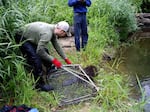Beavers are often relocated because they are beneficial to stream reconstruction and can even help salmon populations by damming rivers. Their dams slow downstream flow and can increase habitats for waterfowl and other creatures.
Relocating beavers began after the 19th-century mass extermination of millions of beavers by trappers. The relocation process included shipping them on trains from Wyoming to New York, moving them around where stream reconstruction was needed and generally not acknowledging the adaptations beaver may have had to their environment. In the ‘50s, there was even a project that involved throwing a beaver named Geronimo out of a plane with a parachute into the Idaho wilderness multiple times.

A beaver is released back into the water,
Courtesy of SDA National Wildlife Research Center's Corvallis Field Station
Researchers even went so far as to introduce American beavers to Europe, thinking that the American beaver and European Beaver were the same species. They are not, as the European beaver is more aggressive, makes dams with less frequency and is intensely monogamous. American women beavers on the other hand have the habit of “cheating” on their partner with other males.
This new study by Oregon State University surveyed a large swath of the Oregon coastal range (an area as large as Vermont). Researchers took genetic material from over 300 beavers. They found that beavers have genetic material calibrated down to the watershed.
OSU researcher Vanessa Petro says that keeping the beavers in the same watershed is important because subtle differences in the landscape can make a difference for beavers.
“Beaver colonies that occupy the South Umpqua basin vs the Upper Nehalem, I mean those are two totally different geographic areas that have different hydrology, vegetation,” Petro says. “So even though to us, we know that both of those locations occur in Western Oregon, they are still pretty different to the wildlife species actually inhabiting them.”
Petro was part of the team that trapped most of the beavers in the survey/ West Coast beavers are unique because they don’t usually build traditional dams across bodies of water. Instead, they create small dens on the embankments.
This research could have profound implications for beaver relocation in the future, as the study suggests only relocating the animals within the watershed that they were found.